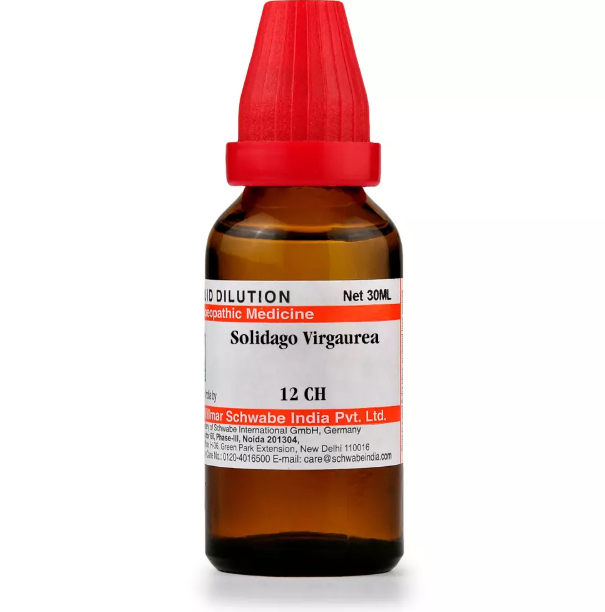SOLIDAGO VIRGAUREA Q, 6C, 12C, 30C, 200C, 1M, 10M USES AND SYMPTOMS
 SOLIDAGO VIRGAUREA
SOLIDAGO VIRGAUREA
(Golden-rod)
Solid.
Inhalation of pollen can cause lung bleeding in those with phthisis. It is linked to recurring colds in tuberculosis (2x), weakness, alternating chills and heat, nasopharyngeal catarrh, burning throat, limb pain, and chest tightness. Pain in the kidney area with dysuria, and sensitivity to pressure. Associated with Bright’s disease and hay fever when Solidago is the trigger. Use the 30th potency or higher in such cases.
Eyes: Red, watery, burning, stinging (ophthalmia).
Nose: Irritated nostrils with excess mucus and sneezing.
Stomach: Bitter taste, mostly at night; coated tongue; urine is brown and sour with scant volume.
Urinary: Scant, reddish-brown urine with thick sediment. Includes dysuria, gravel, and difficulty in urination. Urine may contain albumin, blood, and mucus (albuminuria, hematuria), and kidney pain may radiate to the abdomen and bladder (calculus). Urine can be clear but offensive. Sometimes, it eliminates the need for a catheter.
Female: Enlarged uterus, pressing on the bladder, fibroid tumors.
Respiratory: Bronchitis with cough, thick purulent sputum, blood-streaked; difficulty breathing and asthma with night-time dysuria.
Back: Back pain from kidney congestion (Senec.).
Skin: Blotches, especially on the legs; itching. Eruptions on the lower extremities with urinary issues, swelling, and risk of gangrene.
Relationship: Iodoformium 2x counters the effects of Golden-rod. Ars., Agrimonia eupatoria (kidney pain).
Dose: Tincture up to the third potency. Solidago oil (1 oz to 8 oz alcohol) can be used in 15-drop doses to help with expectoration in bronchitis and bronchial asthma, especially in the elderly (Eli G. Jones).
SYMPTOMS OF SOLIDAGO VIRGAUREA
Eyes:
Red, watery, burning, and stinging eyes (ophthalmia).
Nose:
Irritated nostrils with excess mucus secretion.
Paroxysms of sneezing.
Stomach:
Bitter taste, especially at night.
Coated tongue.
Scanty, brown, and sour-smelling urine.
Urinary:
Pain in the kidney region, sensitive to pressure.
Dysuria, scanty reddish-brown urine with thick sediment.
Albuminuria, hematuria (albumin, blood, and mucus in urine).
Pain extending from kidneys to the abdomen and bladder.
Gravel and difficulty urinating.
Female:
Enlarged uterus pressing on the bladder.
Fibroid tumors.
Respiratory:
Lung bleeding in phthisis
Recurring colds in tuberculosis
Bronchitis with profuse, purulent, blood-streaked sputum
Oppressed breathing and continuous dyspnea (shortness of breath)
Asthma with nocturnal dysuria
Back:
Backache due to kidney congestion.
Skin:
Blotches, especially on the lower extremities.
Itching and exanthema of the lower extremities.
Skin issues associated with urinary disturbances, dropsy, and threatened gangrene.
selection of the potency
Individualization:
- Homeopathy is based on the principle of treating the individual, not just the disease. The unique symptoms and characteristics of the person are crucial in determining the most suitable potency.
Intensity of Symptoms:
- The intensity of the symptoms guides the choice of potency. If the symptoms are intense and acute, a lower potency (e.g., 6C, 30C) might be considered. For chronic conditions with less intensity, higher potencies (e.g., 200C, 1M) may be appropriate.
Sensitivity of the Patient:
- Some individuals are more sensitive to homeopathic remedies, while others may require higher potencies. The practitioner considers the patient’s sensitivity when selecting the potency.
Acute vs. Chronic Conditions:
- Lower potencies are often used for acute conditions, while higher potencies may be considered for chronic or long-standing issues.
Previous Response to Potencies:
- The patient’s response to previous homeopathic treatments helps guide the choice of potency. If a particular potency has been effective in the past, it may be repeated or adjusted as needed.
Vital Force and Susceptibility:
- Homeopathy views illness as a disturbance in the vital force. The practitioner assesses the patient’s overall vitality and susceptibility to determine the appropriate potency.
Aggravation or Amelioration:
- The direction of the symptom response (aggravation or amelioration) after taking a remedy can influence the choice of potency.
Miasmatic Considerations:
- In classical homeopathy, the concept of miasms (inherited disease tendencies) is considered. The practitioner take this into account when selecting the potency.
Practitioner Experience:
- The experience and preference of the homeopathic practitioner play a role. Some practitioners may have success with certain potencies based on their clinical experience.
SAFETY INFORMATION
- Do not exceed the recommended dose by physician
- Keep out of the reach of children
- Store in a cool dry place away from direct sunlight
- Maintain half an hour gap between food/drink/any other medicines and homoeopathic medicine
- Avoid any strong smell in the mouth while taking medicine e.g. camphor, garlic, onion, coffee, hing
Medicine images use for reference only selection of homeopathic medicine depends on the individual’s specific symptoms and overall constitution. Moreover, homeopathy is a holistic system of medicine that treats the individual as a whole. In addition to addressing the physical symptoms, it takes into account the emotional and mental state of the person. Consequently, it’s crucial to consult with a qualified homeopathic practitioner for personalized treatment.
The information provided on this website is intended solely for educational purposes. Always seek the advice of your physician or other qualified health provider.
